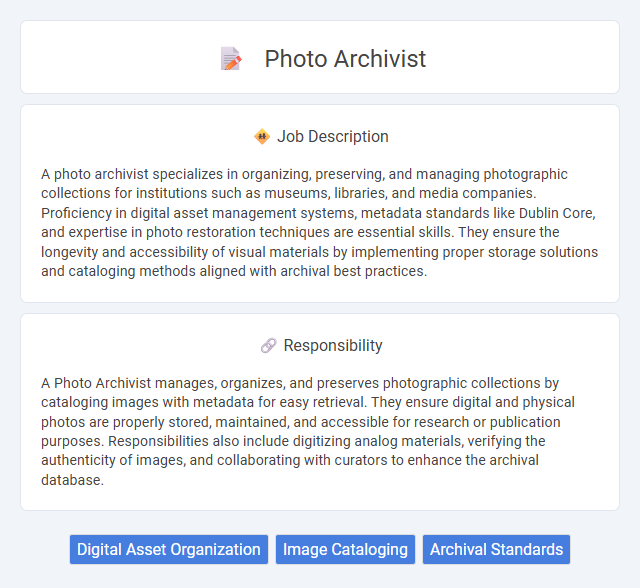
A photo archivist specializes in organizing, preserving, and managing photographic collections for institutions such as museums, libraries, and media companies. Proficiency in digital asset management systems, metadata standards like Dublin Core, and expertise in photo restoration techniques are essential skills. They ensure the longevity and accessibility of visual materials by implementing proper storage solutions and cataloging methods aligned with archival best practices.
Individuals with strong organizational skills and a passion for history or art are likely well-suited for a photo archivist position. Those who prefer solitary, detail-oriented work and enjoy preserving visual records may find this role rewarding. People who struggle with meticulous documentation or prefer fast-paced, social environments might not thrive as photo archivists.
Qualification
A photo archivist typically requires a bachelor's degree in library science, archival studies, or a related field, with specialized training in digital asset management and photographic preservation. Proficiency in metadata standards, digitization techniques, and photo editing software is essential for efficient organization and restoration of photographic collections. Strong analytical skills, attention to detail, and knowledge of copyright laws and historical research methodologies further enhance job performance in managing and curating visual archives.
Responsibility
A Photo Archivist manages, organizes, and preserves photographic collections by cataloging images with metadata for easy retrieval. They ensure digital and physical photos are properly stored, maintained, and accessible for research or publication purposes. Responsibilities also include digitizing analog materials, verifying the authenticity of images, and collaborating with curators to enhance the archival database.
Benefit
Working as a photo archivist likely offers benefits such as preserving valuable historical and cultural visual materials, which can be fulfilling for those interested in history and art. There is probably a strong probability of gaining expertise in digital asset management and archival software, enhancing career prospects in libraries, museums, or media organizations. The role may provide opportunities for collaboration with researchers and curators, increasing professional networking and knowledge-sharing chances.
Challenge
The role of a photo archivist likely involves managing vast collections of images, which can pose challenges related to organization and preservation standards. It is probable that staying updated with evolving digital technologies is essential to effectively catalog and retrieve photographs. Navigating copyright issues and ensuring accurate metadata might also present ongoing difficulties in this profession.
Career Advancement
Photo archivists specializing in digital asset management can advance to senior roles such as digital collections manager or archival consultant, overseeing large-scale projects for museums or media companies. Mastery of metadata standards like Dublin Core and proficiency in software such as Adobe Lightroom and DAM systems significantly enhance promotion prospects. Pursuing certifications from organizations like the Association of Records Managers and Administrators (ARMA) accelerates career growth and industry recognition.
Key Terms
Digital Asset Organization
Photo archivists specialize in the systematic organization and management of digital assets, ensuring images are accurately cataloged with detailed metadata for efficient retrieval. They implement standardized classification systems and use digital asset management (DAM) software to maintain the integrity and accessibility of photograph collections. Expertise in file formats, copyright protocols, and data backup strategies enhances the preservation and usability of digital photo archives.
Image Cataloging
A photo archivist specializes in image cataloging by systematically organizing and indexing photographic collections using metadata standards such as Dublin Core and IPTC. Proficiency in digital asset management systems (DAMS) ensures accurate retrieval and preservation of high-resolution images across various formats. Expertise in keyword tagging, copyright documentation, and version control enhances the accessibility and long-term usability of archival images for research and publication.
Archival Standards
Photo archivists ensure the preservation and organization of photographic collections by adhering to archival standards such as the use of acid-free materials, proper storage conditions, and standardized metadata formats like Dublin Core or IPTC. They apply cataloging techniques and maintain digital and physical archives to facilitate easy retrieval and long-term conservation. Expertise in copyright laws and provenance documentation further supports the integrity and accessibility of photographic archives.
 kuljobs.com
kuljobs.com